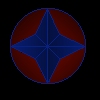

This section will cover the properties of the layout of your map. Youwill learn where and how to place landforms, and what to do about balancingand toning your map. I will discuss each major landform in turn, and thenprovide you with a short list of hints on using those landforms to theirutmost potential.
The concept of balance
Anyone with a bit of knowledge of art should know about balance. Balanceis keeping your picture proportional to the opposite side, with no placebeing 'weightier' than another. Balance in maps is a thing of true delicacy:you have to have places where you draw absolutely nothing, and yet youneed places where the concentration of image is the greatest. Avoidingthese two things can be the downfall of an otherwise truly wonderful map.
All maps need open, flat places and dark, clustered images. To avoidthe clumping of each I recommend long mountain chains and rivers and manysmall clusters of images as though they were netted together into one bigmesh. Try to spread that mesh so that the holes on it are of uniform sizeand shading. Presto-chango, you have balance.
Overview
Overview is where the map is seen from: usually from high above. Whytake overview seriously? Because with overview comes distance, size, andshading.
The distance part of it is fairly obvious. The higher up you seem tobe, the greater the distance it is between any two given points on thepaper. Keep this in mind when deciding how big your land is. If you wantto show 18,000 miles worth of land on one paper, you're going to have todraw very small. If you want to show one mile, however, your images shouldbe larger.
Shading is a tough part of your map. You have to decide where the lightsource of the map is, and stick to it. You can't have mountains shadedon different sides right next to each other: it doesn't look good.
Dead space
Ah, dead space, the scourge of cartographers everywhere. What to dowith dead space? Usually you would want to leave it alone. Sometimes, though,you need something there to achieve balance. I reccommend a compass roseor a distance guage to fill in some of the larger spaces. Vary the typesof images you use to the need for balance; you do not want to upset thebalance in just the opposite way by filling in too much!
The main types of land images
There you have it. You now know how to make all of the necessary imagesthat form a map. If there is a special image that you did not find herethat you need, just make it up. Be sure that other people can tell whatit is, though.